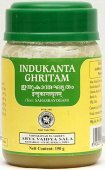Indukanta, Indukānta, Indu-kanta, Imdukamta: 9 definitions
Introduction:
Indukanta means something in Hinduism, Sanskrit. If you want to know the exact meaning, history, etymology or English translation of this term then check out the descriptions on this page. Add your comment or reference to a book if you want to contribute to this summary article.
In Hinduism
Shaivism (Shaiva philosophy)
Source: SOAS University of London: Protective Rites in the Netra TantraIndukānta (इन्दुकान्त) refers to “moonstones”, according to the Netratantra of Kṣemarāja: a Śaiva text from the 9th century in which Śiva (Bhairava) teaches Pārvatī topics such as metaphysics, cosmology, and soteriology.—Accordingly, [verse 18.63-68, while describing the iconography of Mṛtyujit and the consort Amṛtalakṣmī]—“After [the Mantrin] has meditated on the beautiful form as indicated earlier, he should worship Mṛtyujit and Śrī Devī [Amṛtalakṣmī], [...]. [She is as] white as pearls, covered in white clothes, adorned and resplendent with jewels, white garlands of pearls, moonstone, etc. (śuddhahāra-indukānta-ādi) [Amṭralaksṃī is] beautifully adorned with white garlands, wreathes, mālās, [and] lotuses. [She] laughs, has beautiful limbs [and] a bright white smile. [...]”.

Shaiva (शैव, śaiva) or Shaivism (śaivism) represents a tradition of Hinduism worshiping Shiva as the supreme being. Closely related to Shaktism, Shaiva literature includes a range of scriptures, including Tantras, while the root of this tradition may be traced back to the ancient Vedas.
Languages of India and abroad
Sanskrit dictionary
Source: DDSA: The practical Sanskrit-English dictionaryIndukānta (इन्दुकान्त).—the moon-stone. (-tā) 1 night.
2) Name of a plant (ketakī).
Derivable forms: indukāntaḥ (इन्दुकान्तः).
Indukānta is a Sanskrit compound consisting of the terms indu and kānta (कान्त).
Source: Cologne Digital Sanskrit Dictionaries: Shabda-Sagara Sanskrit-English DictionaryIndukānta (इन्दुकान्त).—m.
(-ntaḥ) The lunar gem, the moon-stone. f.
(-ntā) Night. E. indu and kānta a master or husband.
Source: Cologne Digital Sanskrit Dictionaries: Monier-Williams Sanskrit-English Dictionary1) Indukānta (इन्दुकान्त):—[=indu-kānta] [from indu] m. ‘moon-loved’, the moon-stone, [Kādambarī]
2) Indukāntā (इन्दुकान्ता):—[=indu-kāntā] [from indu-kānta > indu] f. night, [cf. Lexicographers, esp. such as amarasiṃha, halāyudha, hemacandra, etc.]
Source: Cologne Digital Sanskrit Dictionaries: Yates Sanskrit-English DictionaryIndukānta (इन्दुकान्त):—[indu-kānta] (ntaḥ) 1. m. Moon-stone. (ntā) f. Night.
Source: DDSA: Paia-sadda-mahannavo; a comprehensive Prakrit Hindi dictionary (S)Indukānta (इन्दुकान्त) in the Sanskrit language is related to the Prakrit word: Iṃdokaṃta.
[Sanskrit to German]
Sanskrit, also spelled संस्कृतम् (saṃskṛtam), is an ancient language of India commonly seen as the grandmother of the Indo-European language family (even English!). Closely allied with Prakrit and Pali, Sanskrit is more exhaustive in both grammar and terms and has the most extensive collection of literature in the world, greatly surpassing its sister-languages Greek and Latin.
Kannada-English dictionary
Source: Alar: Kannada-English corpusIṃdukāṃta (ಇಂದುಕಾಂತ):—[noun] a milky-white, translucent feldspar with a pearly lustre; the moon-stone (supposed to ooze away under the influence of the moon).
Kannada is a Dravidian language (as opposed to the Indo-European language family) mainly spoken in the southwestern region of India.
See also (Relevant definitions)
Partial matches: Indu, Kanta, Imtu.
Starts with: Indukantaghrita.
Query error!
Full-text: Imdupala, Imdukamtopala, Indukantaghrita, Indumani, Imdokamta, Shuddhahara.
Relevant text
Search found 7 books and stories containing Indukanta, Imdukamta, Iṃdukāṃta, Indu-kanta, Indu-kānta, Indu-kāntā, Indukānta, Indukāntā; (plurals include: Indukantas, Imdukamtas, Iṃdukāṃtas, kantas, kāntas, kāntās, Indukāntas, Indukāntās). You can also click to the full overview containing English textual excerpts. Below are direct links for the most relevant articles:
Journal of Ayurveda and Integrative Medicine
Ayurvedic care for post-COVID hypoxia in diabetic, hypertensive patient. < [Volume 13 (issue 2), Apr-Jun 2022]
Outcomes of Ayurvedic care in a COVID-19 patient with hypoxia – A case report < [Volume 13 (issue 1), Jan-Mar 2022]
Ayurvedic treatment rapidly improves oculomotor nerve function in diplopia. < [Volume 15 (issue 2), Mar-Apr 2024]
International Ayurvedic Medical Journal
Ayurvedic management of systemic lupus erythematosus < [2021, Issue 12, December]
Kshayaja shiroroga- a case study < [2016, Issue III March]
Sadyo vaman in tamaka shwas an atyayik chikitsa: a case report < [2019, Issue 2, February]
AYU (Journal of Research in Ayurveda)
Role of Kasahara Dashemani Vati in Kasa and Vyadhikshamatva in children with special reference to recurrent respiratory tract infections < [Volume 34 (3); 2013 (Jul-Sep)]
World Journal of Pharmaceutical Research
Efficacy of Matra Basti in Sigmoid Colon Vascular Ectasia: Case Report < [2019: Volume 8, December issue 13]
Covid-19-an ayurvedic prospective-a case study < [2020: Volume 9, July issue 7]
Review on agastya haritaki rasayana avaleha < [2022: Volume 11, April issue 4]
Vatakaphaja gridrasi management: Urdhva shodana and basti case report < [Volume 7, Issue 1: January - February 2020]
Hypothyroidism in ayurveda - a conceptual study < [Volume 2, issue 4: July - August 2015]
Arogyavardhini Vati - A Boon for Liver Disorders from Ayurveda (Fatty Liver) < [Volume 8, Issue 4: July - Aug 2021]
Journal of Ayurveda and Holistic Medicine
Effect of vamana karma on amavata (rheumatic fever) < [Volume 1, issue 2 (2013)]
Phytochemical screening of septilin drops- a polyherbal formulation < [Volume 2, issue 6 (2014)]
Related products



